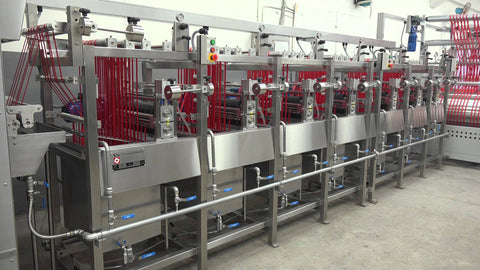Tie Down Colors - Dyeing Processes and Sublimation

Most woven tie down cargo control securements are made from polyester, nylon or polypropylene yarn fibers. Webbing color, UV inhibitors, stiffening agents, anti-wick and other requested chemicals are often imparted via one of several webbing dye processes:
Pigment Dyeing is the most economical dyeing process for polyester tie down webbing. Most of the commodity yellow (acetoacetic acid anilide pigments) straps entered into the stream of commerce have been pigment dyed. The largest problem with pigment dying is the potential for staining or bleeding, called crocking. This occurs most often when an inadequate binder is used in the dyeing process and the color does not lock into the woven yarn fibers. Crocking can cause damage through visible staining to the product being restrained as well as the transportation vehicle.
Disperse Dyeing (or Direct Dyeing) with the Thermosol method offers excellent colorfast and washfast properties and can be economically applied continuously or in large batches. Reproducibility is much easier with disperse dying as well, an important concern when matching specified customers’ colors.
Sublimation Dyeing involves infusing ink directly onto the yarn fibers by pressure and heat. This process, though expensive, can impart complicated graphics and fonts specified by the customer. Sub-dyed webbing can offer a long wear life if properly cared for.
Weaving Solution - Dyed (or Spin Dyed) yarns for a blended effect (black edges on web) is commonly seen in the cargo control industry. Solution Dyeing is a lower cost process for dark colors, e.g. Black, because the dye processing time is greatly minimized. However, extruded into the fiber, the color becomes locked into the fiber. The problem though is that this process often weakens the ultimate strength of the underlying fiber. Ironically, most tie down webbing with black, solution dyed edges are considered premium and stronger than non-edge web straps and tie downs when in fact it is using cheaper dyed fiber and these edges, though they may look appealing, leave the web less strong.
- All Webbing sold by RatchetStrap.com can be spec'd Berry Amendment Compliant.
- Available Web Finishes include Resin Treatment like Polyvinyl butyral ( PVB ), Water Repellency, Fire-Retardancy and Spectral Reflectance. [Polyvinyl butyral (or PVB) is a resin mostly used for applications that require strong binding, optical clarity, adhesion to many surfaces, toughness and flexibilitity.]
-
Vinyl is often used as shorthand for PVC. What differentiates PVC from the other vinyls is the addition of a chlorine molecule (the chloride “C” in PVC). Chlorine is the source of many of the environmental health concerns with PVC, such as the generation of dioxin, a highly carcinogenic chemical produced in both the manufacture and disposal of PVC. Due to its persistent and bioaccumulative nature (it travels long distances without breaking down and concentrates as it moves up the food chain to humans) dioxin has become a global problem and an international treaty, the Stockholm Convention on persistent organic pollutants, now prioritizes the elimination of processes that produce dioxin. Some of the non chlorinated vinyls (EVA, PEVA, PVA and PVB) are now used as direct substitutes for PVC. EVA has been in use for several years as a chlorine-free substitute for PVC – primarily in non building materials like toys and athletic shoes, but occasionally as a protective film or binder. In the building industry, post-consumer recycled PVB is now beginning to be used to replace PVC in carpet backing. Absence of chlorine alone does not make these other vinyls the final answer in the search for green polymers. There are still plenty of toxic challenges and untested chemicals in the life cycle of any petrochemical product. As is the case with most other polymers competing with PVC, however, the weight of available evidence indicates that the absence of chlorine in the formula will generally render the lifecycle environmental health impacts of PVB and the other vinyls less harmful than PVC and initial study is bearing this out. Like the polyolefin plastics, the use of PVB and the other non chlorinated vinyls represents a step forward in the search for alternatives to PVC.

